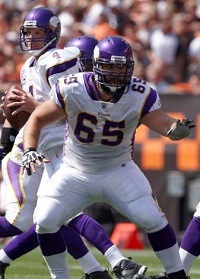[adsenseyu1]
A few weeks ago Jason LaCanfora published a list of best and worst contracts in the NFL so I thought it might make a good idea for us to do the same here at OTC, with a team by team approach. I’ll try to be a bit more analytical in terms of why money was paid and how it fits in the market, but the general premise is the same. The one key difference is outside of restructured rookie contracts under the old CBA we will only use veteran contracts as there is a big difference between best draft picks and best contracts. Please note that there is a difference between a bad player and a bad contract when discussing some of the selections. Clicking on a players name will take you to his salary cap page.
 Best Contract: John Sullivan
Best Contract: John Sullivan
Though he does not have the name recognition of Nick Mangold of the Jets or Ryan Kalil of the Panthers, Sullivan is every bit as good if not better than the biggest name Centers in the NFL. Sullivan is one of the terrific run blockers that helps Adrian Peterson be one of the few Running Back’s in the NFL that actually can carry a team with a subpar passing offense. On top of that when you play with an inconsistent QB like Christian Ponder it puts even greater pressure on the Center to get the line prepared for what may lie ahead.
The Vikings wisely locked Sullivan up in 2011 when he still had one season remaining on his rookie contract rather than allowing him to test free agency in 2012. The Center market had become somewhat overpaid with the emergence of Mangold and Kalil following the wild $37.5 million dollar contract the Rams gave Jason Brown in 2009. Despite the top end prices the Vikings were able to lock Sullivan up at $4.9 million a season, around a 40% discount from the top of the market. The Vikings decision would look even better in light of more expensive contracts given to Chris Myers and Max Unger, both very good players, which may have represented what the market would have been for Sullivan had he hit free agency.
The money saved on Sullivan has allowed the Vikings to overpay to retain the services of Peterson, one of the most important players in the NFL last season. Sullivan’s cap hits will never crack top 5 in a single season and for the next two years he will be outside the top 10. The Vikings cost to cut in 2015, when he will be 30, is only $1 million and the 2016 season contains no dead money. That makes those two years very easy extension years to keep him at a bargain price as he makes the turn past 30 and into the final phase of his career.
 Worst Contract: John Carlson
Worst Contract: John Carlson
For a bit I considered LB Chad Greenway for the worst deal simply because he falls into that category where he is a decent player but paid to be a difference maker, which he is not. But Greenway has a pulse and is around the football enough to have been awarded a trip to the Pro Bowl last year. Carlson, on the other hand, didn’t even produce 10 receptions.
There was no reason for the Vikings to sign Carlson to the type of contract they signed him to in 2012. Carlson had two years of declining performance and importance in Seattle, before missing the entire 2011 season with a shoulder injury. The Seahawks had already decided before the injury that he was not going to be there for the long term and felt a better option was necessary. Somehow the Vikings convinced themselves that he was worth a 5 year contract for $25 million with $9.1 million in guarantees. The decision looks even worse in light of Dustin Keller having to settle for a one year $4.25 million dollar contract this year following a season of injury and Anthony Fasano only grabbing $4 million a year and just a touch more in guarantees on a four year deal. At worst one could argue those players are equivalent to Carlson.
Carlson dealt with injury again in 2012 and, when he played, was completely ineffective in an offense desperate for help in the passing game. 43 yards is about as bad as it gets for a player earning what he earned. Because the Vikings sunk a $5 million dollar signing bonus into Carlson in 2012, his dead money in 2013 was going to be $4 million which made releasing him a tough pill to swallow. The best they could do was reduce his salary by $1.45 million and roll that into an incentive that he can earn by performing better than last season. If released next season Carlson will still count $3 million against the salary cap.
Check out Our Other Best & Worst Contract Articles
AFC East: Buffalo Bills, Miami Dolphins, New England Patriots, New York Jets
AFC North: Baltimore Ravens, Cincinnati Bengals, Cleveland Browns, Pittsburgh Steelers
AFC South: Houston Texans, Indianapolis Colts, Jacksonville Jaguars, Tennessee Titans
AFC West: Denver Broncos, Kansas City Chiefs, Oakland Raiders, San Diego Chargers
NFC East: Dallas Cowboys, New York Giants, Philadelphia Eagles, Washington Redskins
NFC North: Chicago Bears, Detroit Lions, Green Bay Packers, Minnesota Vikings
NFC South: Atlanta Falcons (July 22)
[subscribe2]
[adsenseyu2]

